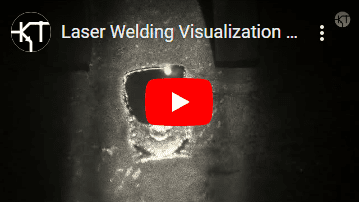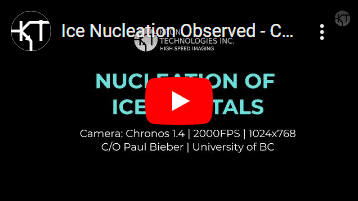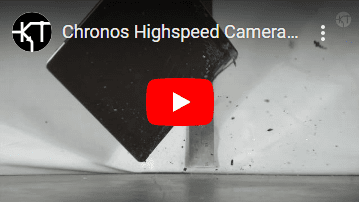High-Speed Cameras for Manufacturing & Industrial Use
Chronos high-speed camera systems offer the portability, ease-of-use, and video quality required by manufacturers, and industrial applications for maintenance and troubleshooting.
Monitoring industrial operations in the pharmaceutical, food and beverage, robotics and automotive industries is critical to improving efficiency, and reliability and reducing downtime. Whether it’s packaging transport, R&D, or quality assurance, observing the fine details of fast-moving processes allows manufacturers to improve their operational abilities. Moreover, predictive machine maintenance allows users to determine potential areas of failure before they happen. This lowers replacement costs in the future making the manufacturing cycle more efficient.
Chronos cameras have been used recently, among other projects, to analyze arc welding modes used in wire arc additive manufacturing[1], to detect seed contamination[2], to select the ripe coffee fruit using a vibration-based approach[3], and to characterize tool vibration[4], instruments of common use in any manufacturing environment.
The all-in-one system includes a robust 5” display and battery pack perfect for portability when troubleshooting assembly lines in a manufacturing facility or R&D department. The ease-of-use virtually eliminates the learning curve and the affordability is perfect for a maintenance team’s budget, so they can focus on the work and not on becoming a camera expert.
Chronos High-Speed Camera can be equipped with a trigger switch for remote control. Other accessories available for your Chronos high-speed camera include data storage devices, illumination sources, lenses, and lens adapters.
Applications
- Material Testing
- Predictive maintenance / Vibration analysis
- Production assembly line inspection
- Machine tools / metal fabrication
- Textile engineering
- Kinematics
- Electronics / PCB Testing
- Automotive research and design
- Robotics
- Packaging
- Additive manufacturing
References
- Panchenko, O., Kurushkin, D., Isupov, F., Naumov, A., Kladov, I. and Surenkova, M., 2021. Gas metal arc welding modes in wire arc additive manufacturing of Ti-6Al-4V. Materials, 14(9), p.2457.
- Gierz, Ł., Przybył, K., Koszela, K., Duda, A. and Ostrowicz, W., 2020. The use of image analysis to detect seed contamination—A case study of triticale. Sensors, 21(1), p.151.
- Cardona, C.I., Tinoco, H.A., Pereira, D.A., Buitrago-Osorio, J., Perdomo-Hurtado, L., Hurtado-Hernandez, M. and Lopez-Guzman, J., 2020, December. Vibration shapes identification applying Eulerian video magnification on coffee fruits to study the selective harvesting. In 2020 19th International Conference on Mechatronics-Mechatronika (ME) (pp. 1-8). IEEE.
- Lambora, R., Law, M. and Mukhopadyay, S., 2022. Recovering cutting tool modal parameters from fractionally uncorrelated and potentially aliased signals. CIRP Journal of Manufacturing Science and Technology, 38, pp.414-426.
Some things to consider when choosing a high-speed camera for manufacturing and industrial use are:
Frame-rate
What is the duration and speed of the event?
Chronos range from 1,000 - 40,000 FPS / 3-16 seconds of record time
Resolution
What is the level of detail required to capture the event?
Chronos range from 1280x1024 to 1920x1080HD max resolution.
Light Sensitivity
What is the lighting sensitivity/contrast required to capture the event?
Chronos range from ISO 320-16,000 depending upon model and sensor type (color or monochrome).
Subject Matter
What is the size and distance from the subject?
Chronos offers a selection of lenses from microscope to 12.5mm-75mm to capture events near or far.
Chronos Cameras in Publications and Journal Articles
Gas Metal Arc Welding Modes in Wire Arc Additive Manufacturing of Ti-6Al-4V
Study by O Panchenko, D Kurushkin, F Isupov, A Naumov, I Kladov and M Surenkova
The authors investigated different metal transfers that can improve the wire arc additive manufacturing techniques of Ti-alloy parts.
To gain further understanding of the metal transfer mechanism the authors employed a Chronos high-speed camera to evaluate the printed walls microstructure. They concluded that the controlled short-circuiting (CSC) mode of metal transfer is the most suitable for printing structures with a thin wall due to the stability presented by the arc. Improvements in metal transfer are crucial, they can lead to further advancements in the aerospace industry and biomedical engineering. High strength, low density, and excellent biocompatibility make Ti-alloys highly demanded.
See the study here: Gas Metal Arc Welding Modes in Wire Arc Additive Manufacturing of Ti-6Al-4V
The Use of Image Analysis to Detect Seed Contamination—A Case Study of Triticale
Study by Łukasz Gierz, K Przybył, K Koszela, A Duda and W Ostrowicz
In agriculture, sowing is a crucial operation in the cultivation of grains and some other crops. The success of the sowing process has a direct influence on the positive outcome of the subsequent operations. Due to its relevance for humans the output of agricultural operations is constantly evaluated in research projects.
The research work of Gierz et al analyzed the variation of seeds in a conveyor. The variability of the triticale seeds, a cross of wheat and rye, was evaluated using a Chronos 1.4 high-speed camera. Since the seeds are not free of contamination, the motivation for their study was to assess the classification error present when the seeds are classified to improve the seed sowing in field operations.
See the study here: The Use of Image Analysis to Detect Seed Contamination—A Case Study of Triticale
Vibration Shapes Identification Applying Eulerian Video Magnification on Coffee Fruits to Study the Selective Harvesting
Paper by C I Cardona, H A Tinoco, D A Pereira, J Buitrago-Osorio, L Perdomo-Hurtado, M Hurtado-Hernandez and J Lopez-Guzman
The researchers analyzed the vibration shape attained by the coffee fruit at a predetermined frequency range. Their goal was to gain insight into the ripening stage's influence on the coffee fruit's dynamic behavior. To that end, the authors set up an imaging system that used a Chronos 1.4 high-speed camera.
The motion of the coffee fruits captured by the high-speed camera allowed the authors to evaluate the shape of the fruits at three different frequencies. Their results can trigger strategies aimed at improving mechanical vibration-based harvesting methods to boost coffee production.
See the study here: Vibration Shapes Identification Applying Eulerian Video Magnification on Coffee Fruits to Study the Selective Harvesting
Recovering cutting tool modal parameters from fractionally uncorrelated and potentially aliased signals
Paper by R Lambora, A Nuhman P, M Lawa, S Mukhopadyay
Lambora et al. used a digital evaluation approach to inspect cutting tool vibration. Due to the high frequency of the cutting tool, image-based monitoring systems require a high frequency as well. To this end they captured simultaneous recordings using a Chronos 2.1-HD high-speed monochrome camera and an accelerometer mounted at the tip of the cutting tool.
The authors report that their approach can be extended to monitor tool condition at lower frame rates, thus the decision to change the tool can be based on a more solid foundation. Another advantage is that lower sampling rates also lead to less data to transmit.
See the study here: Recovering cutting tool modal parameters from fractionally uncorrelated and potentially aliased signals





